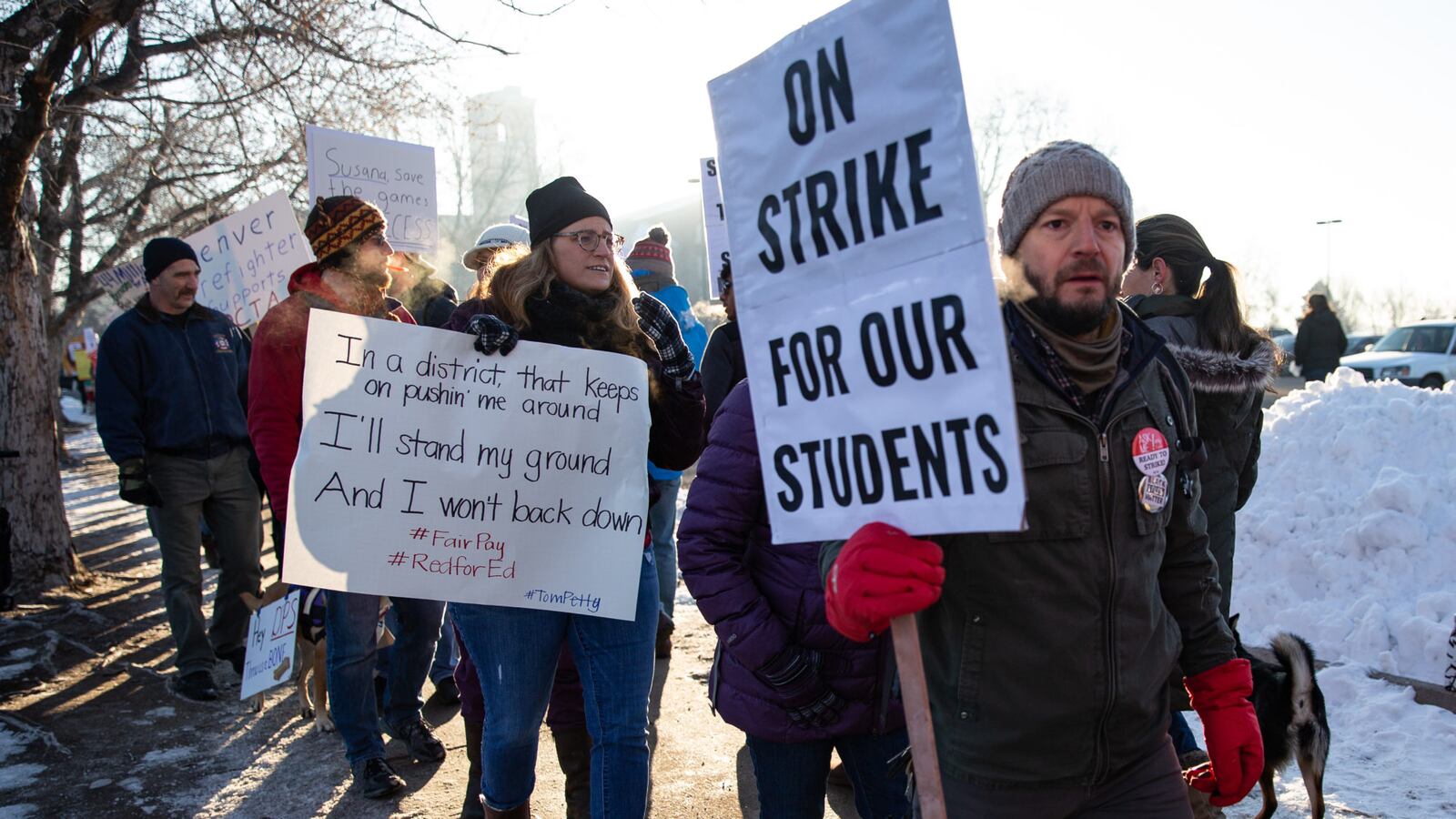A Denver teacher strike heads into its third day after negotiators for the Denver school district and teachers union spent 13 hours trading proposals in the basement of the city’s central library.
They did not succeed in reaching a deal to end the work stoppage. But Denver Public Schools Superintendent Susana Cordova called it “an incredibly productive day. We can certainly see a pathway to getting to an agreement.”
Both sides offered proposals, and then spent hours reviewing what each other had proposed. The reviews were conducted out of view of the teachers who packed the library’s basement auditorium to watch. By 11 p.m., the sizable crowd — which spent the morning chanting so loud, the library politely asked them to hush (no bullhorns or drums, please) — had dwindled to just 20 or so teachers.
Later that evening, Cordova and union president Henry Roman sent an unusual joint statement to Denver Public Schools parents and other community members — indicating the two sides may be closing in on a deal.
“Today, Denver Public Schools and the Denver Classroom Teachers Association worked in good faith to find common ground,” the statement read. They characterized the proposals as moving the two sides closer together and said they need “a little more time to resolve the outstanding issues.”
Denver Public Schools and the Denver Classroom Teachers Association are negotiating how to revamp ProComp, Denver’s complex pay system that offers teachers bonuses and incentives on top of their base pay. The union wants to shrink the size of the bonuses and use the money to boost teachers’ base salaries. The district agrees with boosting base salaries, but is fighting to keep certain bonuses more robust.
The difference is philosophical: District officials believe offering incentives to teachers who work at high-poverty schools helps attract and retain good educators where students need them most. Union officials argue that the way to keep teachers is to offer them stable pay, not bonuses that can come and go each year if, say, a school’s population changes.
Adding yet one more complication to the negotiations, a conservative education advocacy group threatened to file a lawsuit if whatever deal the two sides reach doesn’t conform to its interpretation of a 2005 tax measure that generates $33 million a year to pay for those bonuses.
But Tuesday’s negotiations did not center on the bonuses. Instead, both sides offered revisions to the salary schedule that moved their offers closer together.
The district added a “lane,” bringing the total number of lanes in its proposal to seven. The union’s proposal has eight. That represents significant progress; a year ago, the district’s proposal had four lanes, while the union’s had 12.
Lanes, which represent a teacher’s level of educational attainment, are important because educators get a pay bump each time they move up a lane. The first lane is for educators who have a bachelor’s degree and the last lane is for those who have a doctorate. The disagreement between the two sides is how many lanes should be in the middle.
Right before the two sides broke for the night, the union presented a counterproposal. It keeps eight lanes but arranges them in a way that’s closer to the district’s proposal. Instead of being separated by increments of 15 credits, the union’s latest proposal separates the lanes by increments of 18 credits. The district’s proposal separates the lanes by increments of 20 credits.
The two sides plan to return to the negotiating table at 10 a.m. Wednesday.
Although many educators say they’ll strike until they get the deal they want, there are signs that even the short strike is already taking a toll.
Hayley Gunter, a special education teacher at Schmitt Elementary in southwest Denver, said she is planning to return to the classroom Wednesday.
Asked why, she said, “simply because I can’t afford these unpaid days.” A special education teacher, Gunter said she also worries students’ individual education plans aren’t being met while their teachers are not in the classroom.
Although striking teachers at some schools reported that some in their ranks returned to classrooms Tuesday, the district said teacher attendance was comparable to the previous day’s 56 percent. The union has challenged those figures as low, and said “even more educators” joined picket lines on Tuesday. It did not provide a precise number, as it did the previous day.
Picketing with her colleagues Tuesday outside Dora Moore Elementary School, first-grade teacher Emily Hetzler described mixed feelings among teachers as the strike wore on.
“A lot of people are saying, ‘I don’t know if I can keep going after today. I can’t afford to be missing work after today,” she said. “So I think there’s this mix of feeling very optimistic and excited, and still seeing the support of all the teachers in the district who are out here fighting for what they know is right. But it’s also setting in: We’re not getting paid. We’re away from our students, and how much longer can we keep doing this?”
Three of the 19 teachers who were out on strike Monday returned to Dora Moore on Tuesday, and at least two more are expected to return Wednesday, Principal Karen Barker said. Four teachers never left their classrooms this week.
Eliza Eaton-Stern, a teacher at Denver Green School, spent hours Tuesday as part of the throng of educators in red T-shirts who watched the negotiations from the audience. Before she left, she expressed hope the two sides would come to a resolution soon.
“All we really want,” she said, “is for this strike to be over so we can get back in the classroom.”
Yesenia Robles, Eric Gorski, and Erica Meltzer contributed reporting for this article.

